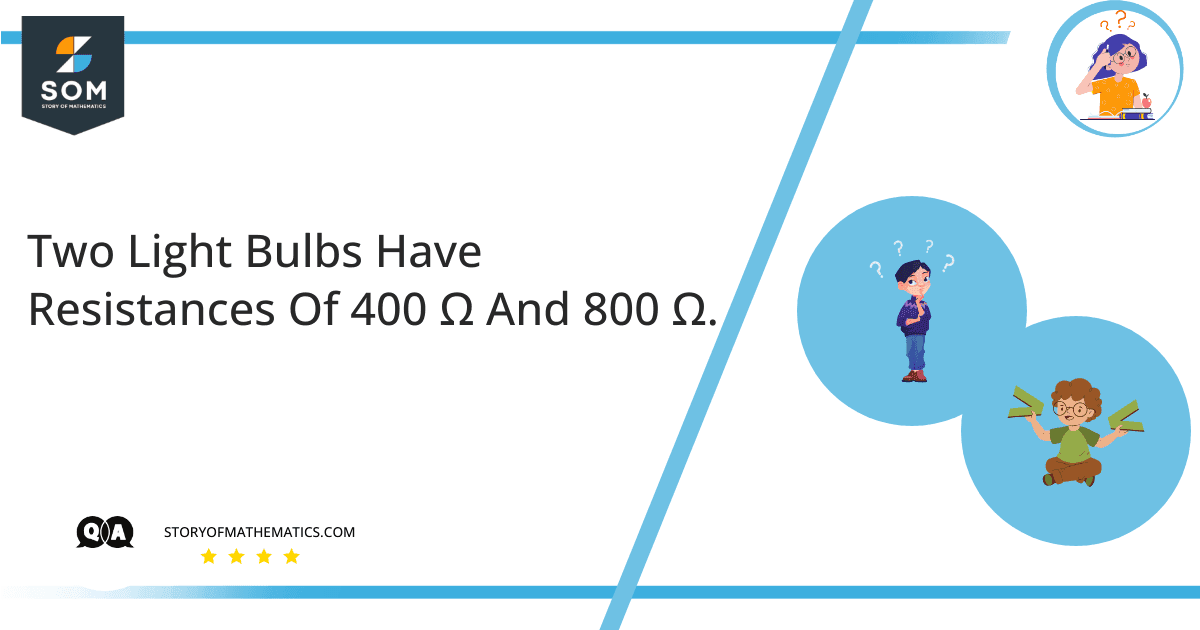
The main objective of this question is to find the power dissipated in each bulb that is connected in series.
This question uses the concept of power in series. In a series circuit, the total power is the same as the total amount of power lost by each resistor. Mathematically, it is represented as:
\[ \space P_T \space = \space P_1 \space + \space P_2 \space + \space P_3 \]
Where $P_T $ is the total power.
Expert Answer
Given that:
\[ \space R_1 \space = \space 400 \space ohm \]
\[ \space R_1 \space = \space 800 \space ohm \]
Voltage is:
\[ \space V \space = \space 1 2 0 \space V \]
We know that:
\[ \space P \space = \space \frac{V^2}{R} \]
So, for the first bulb, we have:
\[ \space P_1 \space = \space \frac{V^2}{R_1} \]
By putting in the values, we get:
\[ \space P_1 \space = \space \frac{1 2 0^2}{4 0 0} \]
\[ \space P_1 \space = \space \frac{1 4 4 0 0}{4 0 0} \]
\[ \space P_1 \space = \space 3 6 \space W \]
Now for the second bulb, we have:
\[ \space P_2 \space = \space \frac{V^2}{R_2} \]
By putting in the values, we get:
\[ \space P_1 \space = \space \frac{1 2 0^2}{8 0 0} \]
\[ \space P_1 \space = \space \frac{1 4 4 0 0}{8 0 0} \]
\[ \space P_1 \space = \space 1 8 \space W \]
Numerical Answer
The power dissipated in the first bulb is:
\[ \space P_1 \space = \space 3 6 \space W \]
And for the second bulb, the power dissipated is:
\[ \space P_1 \space = \space 1 8 \space W \]
Example
In the above question, if the resistance across one bulb is $ 600 $ ohm and 1200 ohm across another bulb. Find the power dissipated along these two bulbs which are connected in series.
Given that:
\[ \space R_1 \space = \space 6 0 0 \space ohm \]
\[ \space R_1 \space = \space 1 2 0 0 \space ohm \]
Voltage is:
\[ \space V \space = \space 1 2 0 \space V \]
We know that:
\[ \space P \space = \space \frac{V^2}{R} \]
So, for the first bulb, we have:
\[ \space P_1 \space = \space \frac{V^2}{R_1} \]
By putting in the values, we get:
\[ \space P_1 \space = \space \frac{1 2 0^2}{6 0 0} \]
\[ \space P_1 \space = \space \frac{1 4 4 0 0}{6 0 0} \]
\[ \space P_1 \space = \space 24 \space W \]
Now for the second bulb, we have:
\[ \space P_2 \space = \space \frac{V^2}{R_2} \]
By putting in the values, we get:
\[ \space P_1 \space = \space \frac{1 2 0^2}{1 2 0 0} \]
\[ \space P_1 \space = \space \frac{1 4 4 0 0}{1 2 0 0} \]
\[ \space P_1 \space = \space 1 2 \space W \]
Thus, the power dissipated in the first bulb is:
\[ \space P_1 \space = \space 2 4 \space W \]
And for the second bulb, the power dissipated is:
\[ \space P_1 \space = \space 1 2 \space W \]
